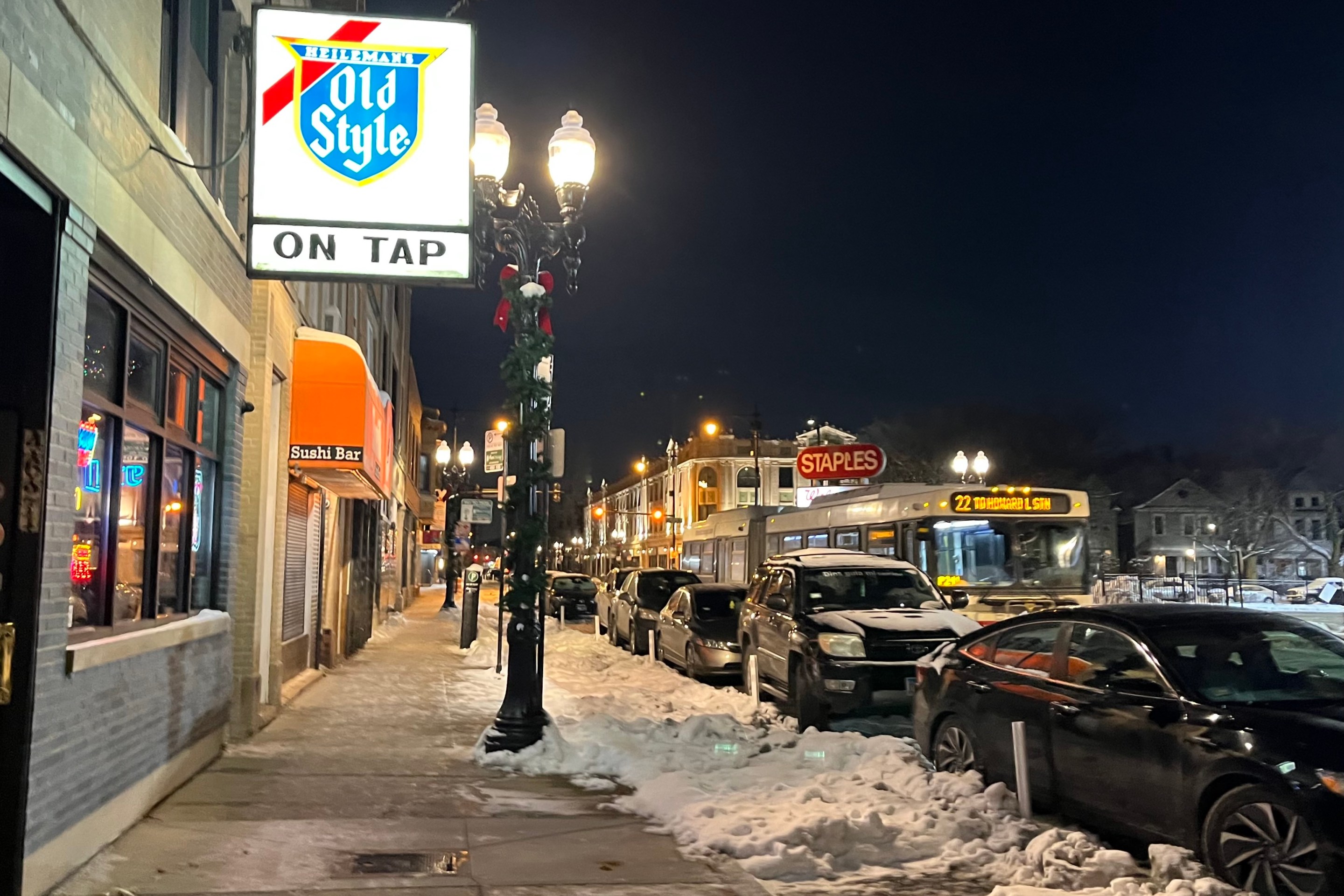This week’s Chicago Reader "First Tuesdays with Maya [Dukmasova] & Ben [Joravsky]" at Nighthawk on the topic of “Public Transit Crisis” lived up to the theme. The conversation with state representative Kam Buckner and activist (and former Streetsblog reporter) Lynda Lopez touched on familiar CTA woes: the ongoing triple-whammy of sub-par cleanliness, safety, and reliability; the predicted $730 million Chicagoland transit system budget shortfall by 2026; and a punishing funding structure that keeps the system hobbled. But it was the audience Q & A where on-the-ground frustrations of riders—and CTA workers in particular—gave a pulse to the urgency of the crisis at hand.
Buckner is a vocal transit advocate who was recently appointed co-chair of Mayor Brandon Johnson’s transportation subcommittee. He talked about problematic policies like the fare box recovery ratio, which requires the CTA to raise half its operations budget from fares, advertising and other income—a much stiffer requirement than any other transit system in the country. There’s also the rule that federal funds to the Regional Transit Authority can only be used on capital projects, not general operating or maintenance. Buckner said the federal infrastructure bill will provide some relief and that the State of Illinois is ready to provide additional necessary funds, but “needs to hear what the CTA would do differently, so we don’t throw good money after bad.”
When Dukmasova asked if this was fair considering the crushing blow the pandemic dealt to public transportation systems across the country, Buckner replied that “The pandemic didn’t break the CTA, it revealed what was already broken.” Lopez said she agreed that the pandemic exacerbated problems that already existed, and that CTA needed to step up its own advocacy efforts and align with community activists to bang the drum for its own survival. She encouraged more expansive thinking about the potential of transit as a place for community connections and hubs of activity, pointing to Los Angeles advocacy group ACT-LA’s recent “Metro as a Sanctuary” report. She also said a silver lining of the current crisis is that transit advocacy seems to be a more mainstream issue than ever before.
Regarding safety and sanitation, Buckner observed that these are ills of low ridership, and that when the system is more reliable, train cars fill with riders and crime goes down. The question of people smoking on trains got a lot of mileage throughout the night, but not unreasonably so. When the solution to discouraging onboard smoking is more riders, and secondhand smoke discourages people from entering train cars, you have a vicious cycle not dissimilar to the “transit death spiral.” No one claimed to have an easy answer to the problem.
However, CTA employees, a few carrying signs protesting poor work conditions, had suggestions for improvements. The first to speak was a bus operator of 17 years and union steward who called for an investigation of CTA spending and more investment in staff, including bringing back conductors on trains to reduce crime. He finished by calling for a revolution and worker control of the agency, to audience applause.
Four CTA workers who separately addressed the panel all reported severely low morale in the agency’s workforce, with some of the attendees asking questions, and some of them making passionate statements. The employees asked for the reinstatement of two-person operating teams on trains—phased out in the 1990s—for the safety of riders and workers alike. A rail mechanic and union steward complained that there is a glut of part-time openings and not enough full-time positions to keep the system running properly and his coworkers out of poverty. “We’ll make too much for Medicaid but not enough for insurance.”
Both CTA workers and other attendees asked about change at the top. A 30-year employee asked if the CTA leadership would be replaced. Buckner said he has no oversight of CTA president Dorval Carter Jr., who was appointed to his job by Mayor Rahm Emanuel in 2015, and kept in control of the agency by Mayor Lori Lightfoot, and now Mayor Johnson. But Buckner did say that he felt change needed to come from the top and Carter’s failure to show up at City Council meetings was “a slap in the face to the people of Chicago.” He also said the Transportation Subcommittee he co-chairs will be issuing a report this Friday to Mayor Johnson and strongly insinuated a change of CTA leadership would be included in the subcommittee’s recommendations.
Joravsky remarked that in the past, when city council members have tried to question CTA leadership they were seen as stepping out of line. Instead such an action being viewed as an attempt to address failures of the agency, it was widely viewed as a power grab.
The next question, from a CTA bus operator, was about replacing the transit board. Buckner again said he could only speak for himself, and that he supports the reinstatement of an advisory board of people “who actually ride the system.” The CTA response to a Freedom of Information Act request from Streetsblog shows that the majority of CTA board members rarely use the services they oversee, and Block Club Chicago reported that Carter only swiped his work pass 24 times in two years.
One attendee expressed gratitude that the CTA has not gone the route of New York’s transit system, which has added police to address crime. They expressed fear that a situation like the murder of Jordan Neely on an MTA train could happen here. Lopez replied that she supported the idea of trained transit ambassadors and social workers on CTA trains to assist people in need of housing and behavioral health services, while acknowledging that it would take significant investment—people in those positions are already underpaid she said and, “transit workers can’t be everything.” In November, the CTA increased starting hourly rates for train and bus drivers from $24 to more than $28, with another bump this year to just under $30 planned this year.
Other concerns voiced throughout the evening were unresponsiveness to requests, and lack of clarity on who complaints should go to, and the recurring theme of just how inextricable problems like poverty and lack of housing are from smoking on trains. At one point Lopez put it concisely, “You see all the social issues of a city on transit.”





